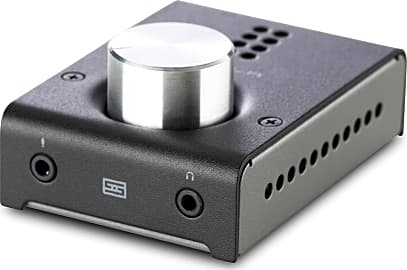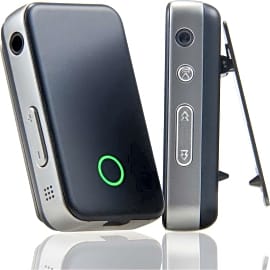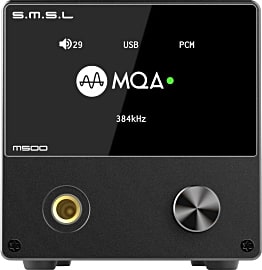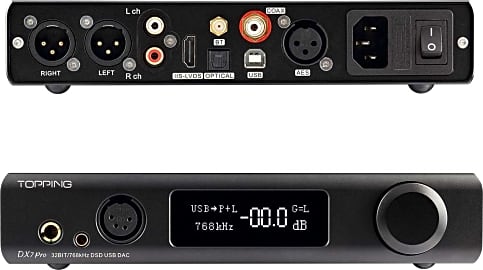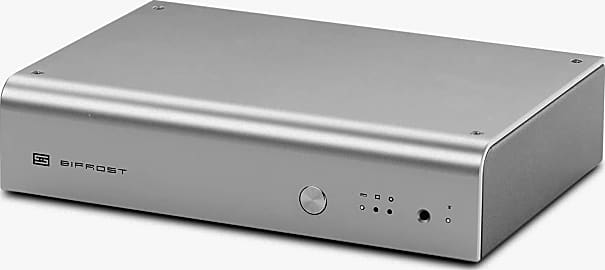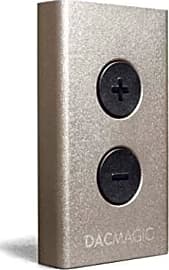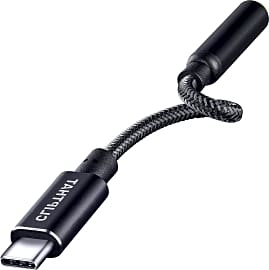The 10 Best USB DACs

This wiki has been updated 39 times since it was first published in October of 2015. Most devices come with underpowered sound cards that fail to do justice to your music files. If you're looking to get the best possible sound quality from your computer, tablet, smartphone, or even your TV, then a decent digital to analog converter is what you need. USB DACs have come a long way in the past few years, and some of these models are compact enough to fit in your pocket. When users buy our independently chosen editorial recommendations, we may earn commissions to help fund the Wiki.
Editor's Notes
December 04, 2020:
There are thousands of DACs on the market, which is a good but confusing thing for most consumers. After extensive research, we swapped in the ClipThat HiFi for a similarly affordable straightforward mode in part because of its support for DSD128 streaming, as well as its robust braided-nylon exterior and low noise floor, which you won't always get with a simple USB-C adapter.
The two Schiit models we previously recommended have been replaced by their successors, one of which is the Schiit Fulla 3. The Modi we decided to move away from, because it's in the same price range as the Fulla, and for the cost, it's very difficult if not impossible to tell a difference between a modular amplifier/DAC stack and an integrated model. Instead of going with the new Modi, we highlight the Schiit Bifrost 2, which is one of the top models from the California-based audiophile group. In truth, all of their products are of top quality, but the Bifrost 2 is notable because it's basically a high-end model, but costs less than many other audiophile-grade options, which can reach into the thousands and are hard to tell apart.
The AudioQuest Dragonfly continues to be the go-to for many PC users, and it's especially nice for laptop users on the go due to its bus-powered design and small form factor. Despite its size, it makes few sacrifices in terms of sound quality. Finally, it's hard to mention USB DACs without bringing up the RadSone EarStudio ES100. This is near-universally regarded as one of the best and most versatile portable headphone amplifiers due to its top-notch wireless codec support, compact and durable construction, and moderate price.
December 24, 2019:
You can spend a little, or a whole, whole lot when choosing a USB-enabled DAC. We were especially impressed with the low price and high satisfaction of the WKWZY Portable, which is hardly any bigger than an everyday Type-C audio adapter, but offers better sound then a majority of smartphones. The NextDrive Spectra X is only slightly larger, and while some of its functionality is restricted when used with Apple devices, for everyone else it's a great choice. The Cambridge Audio DacMagic XS is another highly compact unit, this time with a solid aluminum body in your choice of 4 finishes. Speaking of compact, the RadSone EarStudio ES100 is incredibly popular among wired headphone owners, as it can turn nearly any pair into a powerfully driven and wireless set of cans. The Fiio K3 doesn't have any wireless capability, but it does allow for Direct Stream Digital as well as balanced playback. Meanwhile, the AudioQuest Dragonfly is remarkably popular, thanks in part to its built-in USB plug that makes it great for use with laptops and desktop PCs.
If you're not too concerned with portability but don't want to waste a bunch of shelf space, consider the Schitt Fulla 2, which is surprisingly powerful for such a small device. The Schitt Modi Multibit, also from this irreverently named and newly popular California audio company, is highly recommended by audiophiles who insist on having individual pieces of equipment to take care of every part of the audio production process. The SMSL M500 is a bit larger than both of those, while the Topping DX7 Pro is, admittedly, pretty darn expensive, but in real-world testing it exhibits lower levels of distortion and noise than almost anything else on the popular market.
Special Honors
Resonessence Herus It's small, simple, and highly accurate, and while it does cost over $300, it should satisfy all but the most demanding headphone users. It supports superhuman PCM sampling rates and resolutions in addition to the more obscure and higher-performing DSD format. resonessencelabs.com
Chorde Electronics DACs These guys are incredibly well-known in the audiophile community -- a community that's generally made up of an awfully picky bunch of people. They commonly come up in discussions of the best equipment out there, and no matter which of their DACs you choose -- and they are all expensive -- you will almost certainly be happy. chordelectronics.co.uk
Auralic Vega G2 If money is no object, this one is worth a look, because it's over several thousand dollars but should outperform a vast majority of the competition. It's built with top-of-the-line interior and exterior components and compatible with nearly any advanced format you can throw at it. us.auralic.com
Peek-a-Boo Audio
If you wanted to own an organized representative binary file for each sound produced in a recording studio, your music files would be enormous.
Babies love to play peek-a-boo. One moment you're there, and the next, you're not. Then, you return, maybe making a silly face. It's a game that hooks into the binary nature of our world, of our perception, which, believe it or not, is the very root of computational algorithms. In the case of something like audio rendering, the more expansive and specific the logic, the better the sound quality.
Think of it this way, when you record an acoustic guitar through a microphone and onto an analogue tape deck, that microphone translates the sound of the guitar into an array of electrical signals. Those signals, when magnetized, imprint on the tape with an equally expansive array of magnetic forces, creating a nearly perfect simulacra of the sound originally produced.
To distribute that magnetic signal, those audio masters have to be digitized, a process by which each element of magnetic force meets with a corresponding binary representative. Sound cards in your electronic devices read those binary representatives and recreate their original sounds by way of a digital-audio converter, or DAC. The only problem is that along each step in the pathway, you sacrifice sound quality.
If you wanted to own an organized representative binary file for each sound produced in a recording studio, your music files would be enormous. The best you can do is to get your hands on what's called lossless audio, the file sizes of which average about ten to fifteen times those of the audio you can download from, say, iTunes.
That's because hard drives, CDs and servers alike operate on finite amounts of space, so the more songs Apple or anybody can fit on their servers, the more money they stand to save. To get to this point, they independently determine which chunks of that representative binary map you don't really need to hear. It'd be like having an engineer from one of these music distributors come to your house at dinner time and remove the parts of your meal they figure you don't really need to enjoy. It's manipulative, and it's downright insulting.
Now, your computer already has its own DAC, but these are designed with the assumption that you're not interested in lossless audio, so their quality is severely limited. What a USB DAC can do, by comparison, is take your finest digital audio signals and convert them back into analogue voltage with more nuance and processing power than the majority of sound cards on the market. The result is a truer audio experience than is otherwise possible.
Take A Bite Out Of Your Files
We touched briefly above on the music industry's compression of audio files for easier storage and distribution. The evidence of this compression is most visible when comparing the bit rates of different files. For example, if your music library consists of files downloaded from iTunes, the majority of them is probably going to come in at about 128 kbps, or kilobytes per second.
Still, I'd recommend picking one up and also going out and investing in higher quality files for your favorite bands.
By comparison, CD quality is at least 320 kbps and lossless audio files often linger around 1,500 kbps, more than ten times the amount of data stored per file. Studio masters reach even higher, often breaking 2,000 kbps. Now, to be fair, a bit of this compression eliminates things you either can't hear, or that you don't want to hear, like frequencies below and above human hearing that studio tape can pick up or like strange room noises left over from the studio space itself.
If you use iTunes, you can see the bit rate of all your files just by right clicking on any one of them and choosing 'get info,' then the 'file' tab. The great likelihood is that, if you're reading this, you probably have a decent amount of high quality audio files on your computer already. If, however, you see that most of your files are around 128 or 192 kbps, an outboard DAC isn't going to make very much difference in your life unless the DAC on your sound card happens to be fried.
Still, I'd recommend picking one up and also going out and investing in higher quality files for your favorite bands. The added dynamism and depth will render some songs almost unrecognizable from your current understanding of them.
Conversion For Encryption
You couldn't have digital to analogue conversion without first having analogue to digital conversion. This is not a chicken/egg scenario. Like a tremendous amount of technology in the music industry, digital recording began in the once-exciting world of telephony.
The system, like so many great telephonic inventions, saw its first use during wartime, as Allied soldiers used it to convey complex, encrypted messages.
For this development we can thank a British engineer named Alec Reeves, who first came up with a system of pulse-code manipulation (PCM) in 1937. The technology could render a human voice into a kind of binary and transmit it via telegraph. The system, like so many great telephonic inventions, saw its first use during wartime, as Allied soldiers used it to convey complex, encrypted messages.
To decrypt these messages, soldiers used the first DAC units known to man, which were simple reversals of the technology used to encrypt the messages in the first place.
PCM recordings found their way onto a litany of media over the ensuing 40 years, becoming an integral part of the music industry by the late 1970s, just before the release of the first compact disc prototype, a joint effort between the companies Sony and Philips.


